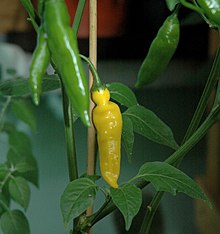Lemon drop pepper
| Lemon drop chilli, ají limón | |
|---|---|
 | |
| Genus | Capsicum |
| Species | Capsicum baccatum |
| Cultivar | 'Lemon Drop' |
| Heat | |
| Scoville scale | 30,000-50,000[1] SHU |
The Lemon Drop pepper or the Ají Limón[2] is a hot, citrus-like, lemon-flavored pepper which is a popular seasoning pepper in Peru, where it is known as qillu uchu. A member of the C. baccatum species, the lemon drop is a cone pepper that is around 60–80 mm (2.4–3.1 in) long and 12 mm (0.47 in) wide with some crinkling.[3] It is commonly mistaken for Ají Limo[4][5] which belongs to Capsicum chinense, ripens to red, and has differently coloured flowers.
Description
[edit]
Plants of the lemon drop variety are typical representatives of the species Capsicum baccatum. In the first year they can reach a height of 1.5 to 2 m (4.9 to 6.6 ft). The plant grows upright and is highly branched. The leaves are dark green and relatively narrow, the petals are whitish - green and carry yellow - green spots on the base. Lemon drop is a high yielding chilli plant, in a year one plant can produce over 100 fruits. The time between fertilization of flowers and ripening of the fruit is about 80 days.[6]
Varieties
[edit]The lemon drop has been confused with ají limo, a different species (C. chinense)[7] has the following variants:[8]
- Ají mochero: Characterized by its citrus scent and bright yellow color.[9]
- Ají miscucho.
- Ají paringo.
- Ají bola.
References
[edit]- ^ "AJÍ LIMO (LEMON DROP)". Cayenne Diane.
- ^ Weaver, William Woys. "How to Grow Aji Limo". Mother Earth News.
- ^ "Aji Lemon Drop". chileman.org.
- ^ "Aji Limo and the imposter Lemon Drop". Hungry Onion. 2023-01-17. Retrieved 2024-09-25.
- ^ "Aji Limo Chile Peppers". specialtyproduce.com. Retrieved 2024-09-25.
- ^ Dave DeWitt and Paul W. Bosland (2009). The Complete Pepper Book: A Gardener's Guide to Choosing, Growing, Preserving, and Cooking. Timber Press. ISBN 978-0881929201.
- ^ {{cite article|title=Introducing Peruvian Aji Chiles, Chile Pepper Institute, Volume VI, Number 3, Fall 1997.
- ^ Investigaciones en Capsicum nativos (PDF) (in Spanish). Universidad Nacional Agraria La Molina. 2012. ISBN 978-612-4147-08-1. Retrieved 1 July 2022.
- ^ "Fruit and seed morphometry of "ají mochero" Capsicum chinense Jacq". AGROSAVIA. 2020. Retrieved 1 July 2022.
External links
[edit]- Ají Limo (Qillu Uchu, Lemon Drop Chili, Lemon Drop Pepper, Ají Limon). Tasteatlas WORLD FOOD ATLAS.
- Acurio, Gastón (2009). Ajíes peruanos: Sazón para el mundo (PDF) (in Spanish). Lima: Ministerio de Agricultura de Perú. ISBN 9786124558306.
